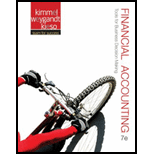
Concept explainers
(a)
Corporation: A business concern where there is a separate legal entity, and are owned by shareholders, are classified as corporation. Transfer of ownership and raising funds are easy in this form of organization. The liabilities of the stockholders to its creditors is limited up to their invested capital amount in the corporation.
To explain: Separate legal existence
(a)
Explanation of Solution
A Corporation has a separate legal existence. It means that the ownership and management are two separate bodies in a corporation. It is not identified by the name of the owners rather identified by its own name. The real owners of the corporation are the shareholders who invests money in the corporation. However, they do not participate in the management of the corporation’s business activities.
(b)
To explain: Limited liability of stockholders.
(b)
Explanation of Solution
The liability of a corporation is limited. It means that the liability of a stockholders is limited only to the extent of their investment amount. This is because, a corporation is a separate legal entity. Thus, the corporation is liable to settle all its debts and obligations from the assets available in the corporation.
(c)
To explain: Transferable ownership rights
(c)
Explanation of Solution
The stockholders gain ownership of a corporation by buying its shares. Being the owners, the stockholders have the complete right to sell a part or all of their shares and thus, easily transfer their ownership to another party without disturbing the normal business operations of a corporation.
Want to see more full solutions like this?
Chapter 11 Solutions
Financial Accounting
- Please provide the accurate answer to this general accounting problem using valid techniques.arrow_forwardI am looking for a step-by-step explanation of this financial accounting problem with correct standards.arrow_forwardI need help with this financial accounting question using accurate methods and procedures.arrow_forward
- At the beginning of the year, Quasar Systems had liabilities of $92,000. During the year, assets increased by $68,000, and at year-end, assets totaled $225,000. Liabilities decreased by $17,000 during the year. What are the beginning and ending amounts of equity for Quasar Systems?arrow_forwardPlease provide the correct solution to this financial accounting question using valid principles.arrow_forwardI need guidance with this general accounting problem using the right accounting principles.arrow_forward
- The financial statements of Isabella Corporation report net sales of $840,000 and accounts receivable of $175,000 and $135,000 at the beginning and end of the year, respectively. What is the average collection period for accounts receivable in days? Need helparrow_forwardCompute the labor quantity variance.arrow_forwardI am trying to find the accurate solution to this general accounting problem with appropriate explanations.arrow_forward

 AccountingAccountingISBN:9781337272094Author:WARREN, Carl S., Reeve, James M., Duchac, Jonathan E.Publisher:Cengage Learning,
AccountingAccountingISBN:9781337272094Author:WARREN, Carl S., Reeve, James M., Duchac, Jonathan E.Publisher:Cengage Learning, Accounting Information SystemsAccountingISBN:9781337619202Author:Hall, James A.Publisher:Cengage Learning,
Accounting Information SystemsAccountingISBN:9781337619202Author:Hall, James A.Publisher:Cengage Learning, Horngren's Cost Accounting: A Managerial Emphasis...AccountingISBN:9780134475585Author:Srikant M. Datar, Madhav V. RajanPublisher:PEARSON
Horngren's Cost Accounting: A Managerial Emphasis...AccountingISBN:9780134475585Author:Srikant M. Datar, Madhav V. RajanPublisher:PEARSON Intermediate AccountingAccountingISBN:9781259722660Author:J. David Spiceland, Mark W. Nelson, Wayne M ThomasPublisher:McGraw-Hill Education
Intermediate AccountingAccountingISBN:9781259722660Author:J. David Spiceland, Mark W. Nelson, Wayne M ThomasPublisher:McGraw-Hill Education Financial and Managerial AccountingAccountingISBN:9781259726705Author:John J Wild, Ken W. Shaw, Barbara Chiappetta Fundamental Accounting PrinciplesPublisher:McGraw-Hill Education
Financial and Managerial AccountingAccountingISBN:9781259726705Author:John J Wild, Ken W. Shaw, Barbara Chiappetta Fundamental Accounting PrinciplesPublisher:McGraw-Hill Education





